|
|
Man o'War

|
|
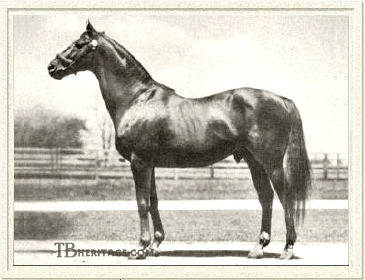 |
|
|
His groom called him "de mostest hoss that ever was" and that about sums it up for Man o'War in the eyes of most American racing fans. Man o'War was not just a great racehorse -- he became the standard by which all runners have been compared then and ever since. Everything he did was bigger than life, his accomplishments on the track, his dominance as a stallion, and his tremendous charisma that drew visitors from around the world to see him in life and in death. Man o'War, a horse of mythic proportions, was probably the greatest American racehorse ever, and the masterpiece created by the great breeder August Belmont.
|
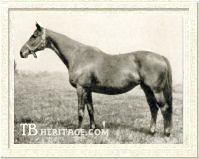
Mahubah
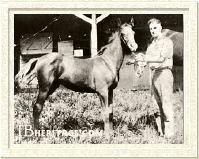
Man o'War as a foal
| |
The story started in the wee hours of March 29, 1917, when Belmont's young *Rock Sand mare Mahubah went into labor to deliver her second foal. It was a big one -- a tall, leggy chestnut colt with a star like his sire's, Fair Play's. Fair Play had been a top class racehorse and was well into a successful career as a stallion, this colt being in his seventh foal crop. (Fair Play's career is handled in more detail elsewhere in the Portrait section).
The mare, Mahubah, was lightly raced, as were many Belmont-bred fillies. She had won a race, but being rather high strung like her sire, the imported English Triple Crown winner *Rock Sand (whose stall at Nursery Stud was heavily padded to reduce injury to himself), was retired shortly after proving her ability on the track. Mahubah's first foal was Masda, a 1915 filly by Fair Play, who was also excessively nervous, but managed to win 6 races from 23 starts. (Masda was the dam of 3 stakes winners and became the third dam of Triple Crown winner Assault. Her female line survives to this day.) Mahubah produced only 5 foals, all by Fair Play, and besides Masda, these included the good stakes winner My Play (1919), winner of the Jockey Club Gold Cup at 5 and a good sire. |
Mahubah was a half-sister to the stakes winner Tactics (g. 1909), by Hastings, and a full sister to the stakes winner Sand Mole (c. 1912). Their dam, *Merry Token, had been imported by Belmont in 1902 at the age of 11. She had won some minor stakes in England and was a half-sister to Tanzmeister.
By 1917, Belmont was sitting on a gold mine. While several of Fair Play's earliest stakes winners had been out of homebred mares by *Rayon d'Or and mares by Hanover, the daughters of *Rock Sand (who first stood at Nursery Stud in 1907) were just beginning to retire to the broodmare paddocks. The first of them reached Fair Play in 1912, and the cross resulted in the stakes winner Sands of Pleasure (1913), followed by Mill Maid (1914). The 1916 crop, still just yearlings at the time, would produce Mad Hatter and Tailor Maid, both stakes winners from *Rock Sand mares. The next few crops were even more heavily invested in the cross, and ultimately, 18 stakes winners resulted from that direct nick. Mahubah's colt by Fair Play was the best of these, and Belmont probably had a good idea of what he had.
War had broken out in Europe and Belmont volunteered for military service, becoming Maj. Belmont. He arranged to sell most of the yearling crop of 1918 at the Saratoga yearling sale, but intended to keep Mahubah's colt, which his wife had since named "My Man o'War." At the last minute, the Fair Play-Mahubah colt was included with the lot and sent to Saratoga. The Nursery Stud consignment was topped by the sale of Fair Gain, a colt by *Vulcain (by *Rock Sand) out of *Fairy Gold (and so a half-brother to Fair Play and Friar Rock), at $14,000, while the Fair Play-Mahubah colt brought a hefty $5,000, against the sale average of $1,038. The colt, whose name became simply "Man o'War" went home with Louis Feustel, trainer for newcomer Samuel D. Riddle, of Glen Riddle Farm.
Man o'War on the Turf
Man o'War was not an easy horse to break, showing much of the fiery nature inherited from Fair Play and Hastings, probably enhanced by the nervous energy coming from Mahubah and *Rock Sand. As a yearling, he had been a gawky, spare-looking individual that appealed to many, including Riddle, as a potential hunter-jumper. Many considered him something short of elegant, but he filled out into a truly magnificent specimen, tall and powerfully muscled, with the high head carriage of the Fair Plays. Man o'War's running gait was unusual, a bounding leap that covered a tremendous amount of ground. He was a free-running horse and despite his size, showed tremendous agility and acceleration at the break.
His reputation in workouts preceded him, and Man o'War was the favorite in his racing debut, which he won, a 5 furlong maiden race at Belmont on June 6, 1919, by 6 lengths. Three days later he won the Keene Memorial (5.5f.) by 3 lengths, and followed up with victories in the Youthful Stakes (also 5.5f.), and Hudson Stakes (5f.) before the end of the month, winning both wire-to-wire. This wasn't just another good 2-year-old, however. In his first 2 races, he had carried 115 pounds, and was bumped up to 120 for the Youthful. His impost in the Hudson Stakes was a whopping 130 pounds, a weight which he carried in his next 5 starts.
|
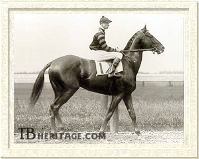
| |
Man o'War raced just once in July, taking the Tremont Stakes (6f.) from flagfall to finish, and moved on to the prestigious Saratoga meet in August. He won the United States Hotel Stakes (6f.) by 2 easy lengths over Upset, but they met again 11 days later in the Sanford Memorial Stakes (6f.). In that event, the circumstances of which have become legendary, Man o'War's stablemate *Golden Broom set the pace, followed by Upset and then Man o'War himself, boxed behind the lead pair. Upset took over the lead into the stretch from *Golden Broom, who was tiring on the rail, but Man o'War had to go wide and around Upset to get past, and in doing so, ran out of room, with Upset hanging on for the win by half a length.
|
Man o'War turned the tables in their next start, the Grand Union Hotel Stakes, (6f.), which he won by a length from Upset, then rounded out the season with wins in the Hopeful Stakes (6f.) by 4 lengths, and the Belmont Futurity (6f.) by 2 1/2 lengths, when asked to carry "only" 127 pounds, beating John P. Grier, a stablemate to Upset. It was only September, but Man o'War went into winter quarters at Glen Riddle Farm near Media, Pennsylvania with the growing reputation as a "wonder horse."
The Fair Play colt opened his 3-year-old season with a win on May 18 in the Preakness Stakes (9f.) at Pimlico, defeating Upset (who had been second in the Kentucky Derby) by a length and a half, with Wildair in third. In the Withers Stakes (8f.), Man o'War romped home by 2 lengths ahead of Wildair, setting a new American record for the mile in 1:35 4/5. In the Belmont Stakes (11f.), the Riddle colt had scared off all but one challenger, the colt Donnacona, and Man o'War was absolutely devastating, winning by 20 lengths and setting another American record for the distance in 2:14 1/5. Taken back to a mile again in the Stuyvesant Handicap, and shouldering 135 pounds, Man o'War faced only Yellow Hand (carrying 103 pounds), and won by 8.
In the Dwyer Stakes (9f.), with only 126 pounds, he again faced just one other starter, but this time it was the improving John P. Grier, with a feathery 108 pounds aboard. Grier ran with the big horse, one of the few times Man o'War was ever challenged for the lead, but still, the champion drew off to win by a length and a half, setting a new American record for the 9 furlongs in 1:49 1/5. After nearly a month off, Man o'War returned to action at Saratoga in the Miller Stakes (10.5f.), carrying 131 pounds, and beat Donnacona by 6 lengths in the process. In the Travers Stakes (10f.), the juggernaut entry of Upset and John P. Grier was thrown at him, but Man o'War still went wire-to-wire, winning by daylight, with 129 pounds in the saddle. In the marathon Lawrence Realization (13f.), he faced only Hoodwink, with 116 pounds to the champion's 126, and Man o'War won by a guestimated 100 lengths.
In the Jockey Club Stakes over 12 furlongs (later known as the Jockey Club Gold Cup and run at 2 miles), Man o'War won by 15 lengths from his lone pursuer, Damask. In the Potomac Handicap at Havre de Grace, he carried 138 pounds and won by 1 and a half lengths, beating Wildair, carrying 30 pounds less.
Now a match raced had been offered and agreed upon between the 3-year-old sensation Man o'War and the older champion Sir Barton, who dominated his crop at 3 and 4. The previous season, Sir Barton had won the Kentucky Derby, Preakness, and Belmont Stakes, before that race became known as "the Triple Crown" of American racing. In the match race at 10 furlongs, known as the Kenilworth Park Gold Cup, Man o'War ran Sir Barton off his feet and won by 7 lengths in a humiliating display of superiority. That said, Sir Barton was giving the year-younger colt 6 pounds and was suffering a flare up of chronic hoof problems at the time. A film of the race shows Sir Barton floundering behind Man o'War the entire trip, looking like a beaten horse every step of the way.
That final victory marked the end of Man o'War's race career, of 20 wins in 21 starts and $249,465 in earnings, a new record. Owner Riddle opted to retire him at this young age rather than face the crushing weights the handicappers had promised to impose on the red horse to make it fair for his opposition. Man o'War retired to Hinata Farm, north of Lexington, Kentucky which Riddle leased while shopping for a farm of his own. The horse and his retinue of mares and youngstock was relocated to Faraway Farm a couple of years later where Man o'War remained one of the biggest tourist attractions in the state until his death.
Man o'War in the Stud
The first crop by Man o'War was foaled in 1922. It was an exciting group, especially so because Riddle had taken the advice of expert horsemen like John Madden and bloodlines specialist William Allison in selecting the broodmares that were to be his first mates. Riddle was often criticized for the mares he allowed to be bred to Man o'War, but in retrospect, this seems to be the result of a "sour grapes" attitude rather than actual deficiency in quality. The proof came on the race track, as that first crop produced 3 champions -- the colt American Flag (Belmont, Dwyer, Withers Stakes) and the fillies Florence Nightingale (C.C.A. Oaks) and Maid At Arms (Alabama Stakes, Pimlico Oaks), all of which dominated the 3-year-old division of 1925.
|
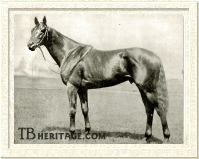
American Flag
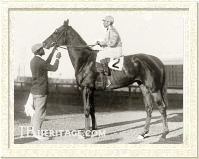
Florence Nightingale
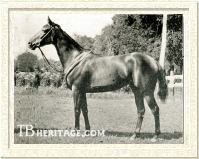
Bateau was Champion 3 year old filly
| |
American Flag (out of *Lady Comfey by Roi Herode) bore a striking resemblence to his sire, and retired to stud alongside him at Faraway Farm. He proved a successful sire despite limited opportunities, getting 16 stakes winners led by the champion 2-year-old filly Nellie Flag, who became a top broodmare for Calumet Farm (dam of champion Mar-Kell, Kentucky Oaks winner Nellie L., and Sunshine Nell) and established an important female line that later produced Forego, Bold Forbes, and Saratoga Six. American Flag also sired Gusto (Jockey Club Gold Cup), Gay Dalton, Flag Pole, and Greek Flag. Besides Nellie Flag, several of his daughters left a mark, particularly Lady Glory, whose daughter Raise You produced the top sire Raise A Native.
Man o'War's second crop produced one of his greatest runners, the glorious golden chestnut Crusader (1923 out of Star Fancy by *Star Shoot) won the Belmont Stakes, Jockey Club Gold Cup, and Suburban Handicap at 3 and was considered one of the best of his era. As a sire, Crusader was a serious disappointment, and only appears in modern pedigrees through his daughter Heatherland (dam of stakes winner and producer Heather Time, by Time Maker). Another from the 1923 crop was the champion 3-year-old filly Edith Cavell (out of The Nurse by Yankee), who won the C.C.A. Oaks, Latonia Oaks and Pimlico Cup (against males), and won a second Pimlico Cup at the age of 5. The 1923 crop also included the Travers Stakes winner Mars (out of Christmas Star by *Star Shoot). The 1924 crop produced the champion 2-year-old and Futurity winner Scapa Flow.
With only 3 crops racing, Man o'War was America's Leading Sire in 1926. He continued to sire a batallion of good runners, although dominated by classic level performers and later-maturing handicappers in the tradition of his sire Fair Play. The outstanding racemare Bateau (1925) was a top 2-year-old, won the C.C.A. Oaks at 3, and matured into one of the best handicappers, male or female, in the country, winning the Suburban Handicap and Whitney Stakes at 4. |
Clyde Van Dusan (1926), won the Kentucky Derby in 1929. Champion Steeplechaser Battleship (1927) carried Man o'War's reputation to England, where he won the Grand National Steeplechase at the age of 7, and became a successful sire of steeplechasers in his own right. Man o'War also sired Blockade (1929), the three-time winner of the grueling four-mile Maryland Hunt Cup.
War Hero (1929) won the Travers and Saratoga Cup. War Glory (1930) won the Lawrence Realization and Dwyer Stakes. He was a useful sire and left 2 daughters to continue his bloodline, both of which produced outstanding runners to the cover of Determine. Gloire Fille was the dam of champion 2-year-old and good sire Warfare (1957), while War Whisk foaled the 1962 Kentucky Derby winner Decidedly.
Man o'War's stud record began to tail off in the mid-1930s, coincident with the rising favor of expensive imported stallions such as *Sir Gallahad III, *Sickle, and *St. Germans.
|
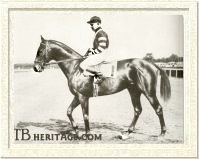
War Admiral
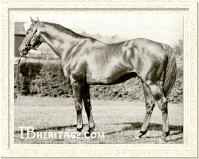
Hard Tack
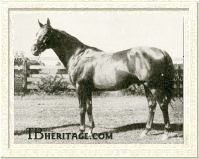
War Relic
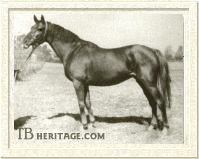
Valkyr, winner of 9 races, and dam of Vagrancy, Vicar, Vicaress and Hypnotic, all stakes winners.
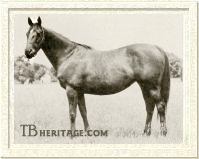
Speed Boat, dam of Level Best
| | He experienced a revival with the appearance of his brilliant champion War Admiral, who won the Triple Crown of 1937 and was second only to kinsman Seabiscuit (sired by Man o'War's son Hard Tack) as a handicap star in 1938. War Admiral became a very good sire himself, getting the filly Busher, 1945 Horse of the Year, the same season he was America's Leading Sire. War Admiral also sired the champion 2-year-old colt Blue Peter, the outstanding handicap mares Searching and Busanda, as well as Mr. Busher, Navy Page, Cold Command, and Admiral Vee. A few sons of War Admiral were decent sires, Mr. Busher in particular, but his daughters became gold mines, and he was a leading broodmare sire for many years, getting the dams of Buckpasser, Hoist the Flag, Affectionately, Never Say Die, Jet Action, and many, many more.
Man o'War's inbred son War Relic appeared in 1941, and beat the 3-year-old champion Whirlaway in the Narragansett Special, and older horses in the Massachusetts Handicap that season. Of all the sons of Man o'War, War Relic became the best stallion and the primary male-line link for his sireline to the future. War Relic specialized in precocious juveniles, like champion Battlefield, Relic, and Missile. All 3 became useful sires, especially Relic, who went to France and sired the sprinters Buisson Ardent and his brother Silver Shark, also Venture VII, Texana, Relance (dam of Relko), El Relicario (dam's sire of Caro), Mystic II (a top sire of steeplechasers), and the American runner and sire Olden Times.
War Relic's most influential son, Intent, was a classy stakes winner who won the San Juan Capistrano Handicap twice. Intent sired the sprinter/miler Intentionally, who became an important foundation sire for the Florida industry, getting the good grass horse Tentam, and the middle distance runner In Reality, who took over from his sire in Florida. In Reality became an outstanding sire, with the top fillies Desert Vixen and Truly Bound, and good colts Known Fact (2,000 Guineas), Proper Reality, Smile, and Believe It. In Reality was also a good sire of sires, with the success of Valid Appeal, Relaunch, Known Fact, and Believe It, his most influential sons.
Man o'War's daughters became tremendous broodmares in their own right. They produced outstanding runners such as Vagrancy, Level Best, Pavot, High Fleet, Blue Swords, Dawn Play, War Plumage, Columbiana, Mata Hari, Bushranger, Dauber, and many more. He nicked particularly well with many of the imported sirelines, especially Hyperion's sons *Heliopolis, *Alibhai, and *Khaled, as well as *Sir Gallahad III, Count Fleet, Equipoise and Blue Larkspur.
Man o'War was retired from stud service due to a heart condition a few years before his
death in 1947. He died on November 1 of that year as a result of a heart attack, at the age of 30, and the news shocked the nation. His body was embalmed and placed in an oak coffin, where he lay in state for visitors. He was buried a few days later in a public radio broadcast. Riddle had set aside ground at Faraway Farm for Man o'War's grave and those of some of his best offspring, and had a lifesize bronze statue of the great horse erected over the grave. This ground was given as a park to the city of Lexington upon Riddle's death. In the early 1970s, the graves and statue were moved to the newly developed Kentucky Horse Park, where they remain today.
|
The statue is a good likeness of the great stallion, who was a large (16.2h.), big boned individual with great substance and presence. Man o'War was a vibrant red chestnut with a rounded star and faint stripe on his face, which was slightly roman in profile. Like his sire, he carried the Bend Or spots coming through Fair Play's dam, *Fairy Gold (by Bend Or).
Man o'War's influence on the breed was profound, and although his male line barely survives through small, dark descendants of In Reality and Relic, his legend as a racehorse and sire will live on.
--Anne Peters
|
|
|
|

